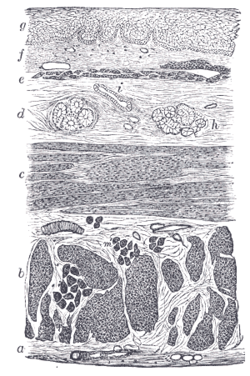Lamina propria
| Lamina propria | |
|---|---|

Layers of stomach wall:
|
|

Section of the human esophagus. Moderately magnified. The section is transverse and from near the middle of the gullet.
|
|
| Identifiers | |
| FMA | 62517 |
|
Anatomical terminology
[]
|
|
The lamina propria is a constituent of the moist linings known as mucous membranes or mucosa, which line various tubes in the body (such as the respiratory tract, the gastrointestinal tract, and the urogenital tract).
The lamina propria (more correctly lamina propria mucosæ) is a thin layer of loose connective tissue, or dense irregular connective tissue, which lies beneath the epithelium and together with the epithelium constitutes the mucosa. As its Latin name indicates, it is a characteristic component of the mucosa, "the mucosa's own special layer". Thus the term mucosa or mucous membrane always refers to the combination of the epithelium plus the lamina propria.
The connective tissue of the lamina propria is very loose, allowing it to be very cell rich. The cell population of the lamina propria is variable and can include, for example, fibroblasts, lymphocytes, plasma cells, macrophages, eosinophilic leukocytes, and mast cells. It provides support and nutrition to the epithelium, as well as the means to bind to the underlying tissue. Irregularities in the connective tissue surface, such as papillae found in the tongue, increase the area of contact of the lamina propria and the epithelium.
The lamina propria contains capillaries and a central lacteal (lymph vessel) in the small intestine, as well as lymphoid tissue. Lamina propria also contains glands with the ducts opening on to the mucosal epithelium, that secrete mucus and serous secretions. The lamina propria is also rich in immune cells known as lymphocytes. A majority of these cells are IgA-secreting B cells.
The lamina propria is a loose connective tissue, hence it is not as fibrous as the underlying connective tissue of the submucosa. The connective tissue and architecture of the lamina propria is very compressible and elastic, this can be seen in organs that require expansion such as the bladder. The collagen in the lamina propria of elastic organs has been shown to play a major role in mechanical function. In the bladder the collagen composition of its lamina propria allows for structure, tensile strength, and compliance, through complex coiling. It has been suggested that myofibroblasts also reside in the lamina propria of several organs. These cells have characteristics of both smooth muscle and fibroblasts.
...
Wikipedia
